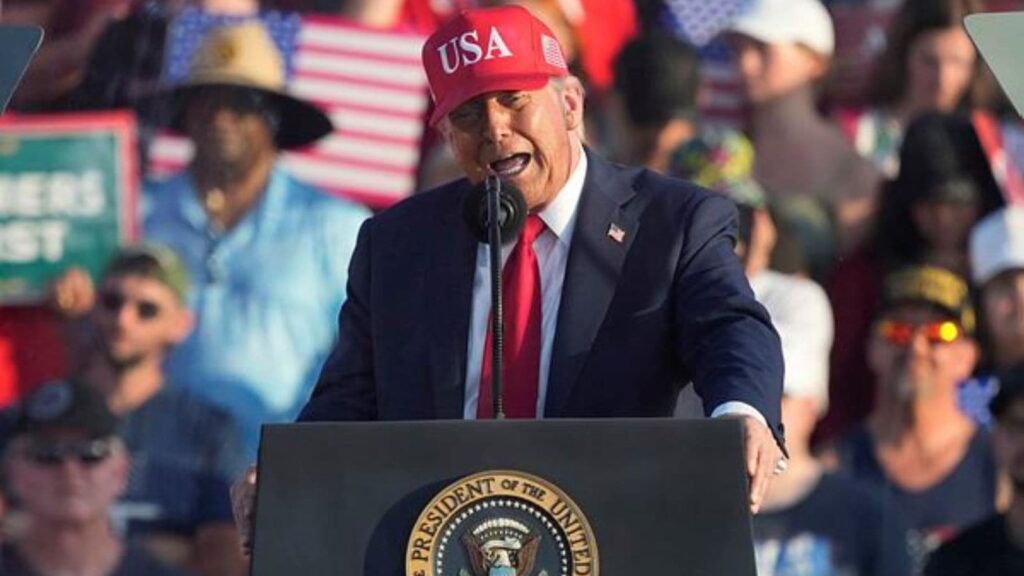970x125
In his latest threat against the BRICS nations, US President Donald Trump on Tuesday reiterated his warning that members of the bloc would be hit with a 10 per cent tariff. Responding to a question during a meeting of his Cabinet, the US President said the coalition was set up to “degenerate” and “destroy” the dollar “so that another country can take over and be the standard”.
970x125
“And that’s OK if they want to play that game, but I can play that game too. So, anybody that’s in BRICS is getting a 10 per cent charge… If they are a member of BRICS, they are going to have to pay 10 per cent tariff, just for that one thing. And they won’t be a member (for) long,” Trump said, adding that the collective had “largely” broken up after his warning last year and was not a “serious threat”.
“…if we lost the world standard dollar, that would be like losing a war, a major world war. We would not be the same country any longer. We are not going to let that happen… The dollar is king. We are going to keep it that way. If people want to challenge it, they can. But they are going to have to pay a big price. And I don’t think any of them are willing to pay that price,” he added on Tuesday.
The American President’s latest threat comes as the BRICS – which started with Brazil, Russia, India, China, and South Africa but has grown to include Egypt, Ethiopia, Iran, the United Arab Emirates, and Indonesia – concluded its 17th summit in Rio de Janeiro, Brazil. BRICS now accounts for 45 per cent of the global population and contributes over 35 per cent to the world’s GDP.
In June 2022, Russia proposed the creation of a new international reserve currency based on a basket of currencies from BRICS countries. However, according to a BRICS report, member nations said they “do not seek to replace the US dollar as a medium of exchange”. Instead, BRICS aims to “offer a viable alternative that will aid the market in its perpetual mission for efficiency” and foster greater prosperity, promoting universally beneficial and inclusive economic globalisation.
BRICS point-of-view
Trump’s threats coincide with the US dollar hitting a three-year low this year, after declining by over 10 per cent against a basket of currencies such as the euro and yen, due to expected disruptions in the US economy stemming from proposed tariffs.
In October 2024, External Affairs Minister S Jaishankar clarified that while US policies often complicate trade with certain countries, and India sought “workarounds” in pursuit of its trade interests, it did not “target” the dollar or seek to move away from it. Later, in December 2024, then Reserve Bank of India (RBI) Governor Shaktikanta Das had said India was not pursuing “de-dollarisation” and that steps such as entering into local currency trade agreements were intended to only “de-risk” Indian trade.
Story continues below this ad
A key reason why India is not backing de-dollarisation is the rise of the Chinese yuan as a challenger to the US dollar. India has resisted using the yuan for Russian oil imports, even as the currency’s acceptance grows in Russia. Following Western sanctions on Russia, including the freezing of $300 billion in Russian foreign holdings, the yuan has become Russia’s most traded currency. According to the Russian government, more than 90 per cent of trade settlement between the two countries is now conducted in roubles.
Ajay Sahai, Director General & CEO of the Federation of Indian Export Organisations (FIEO), the country’s top trade promotion body, told The Indian Express earlier that while supporting local currency initiatives, India should ensure the framework does not disproportionately favour China, given the asymmetry in economic power among BRICS nations.
August 1 tariff deadline
Separately in a post on Truth Social, Trump said on Tuesday that the August 1 tariff deadline decided in the letters sent by the US to its trade partners was final.
“As per letters sent to various countries yesterday, in addition to letters that will be sent today, tomorrow, and for the next short period of time, TARIFFS WILL START BEING PAID ON AUGUST 1, 2025. There has been no change to this date, and there will be no change. In other words, all money will be due and payable starting AUGUST 1, 2025 – No extensions will be granted. Thank you for your attention to this matter!” Trump posted.
Story continues below this ad
Earlier, on Monday, when asked if the deadline was absolute, the US President had told reporters that it was “firm but not 100 per cent firm” and was dependent on the offers made by various countries.
On Monday, Trump said the US would impose 25 per cent tariffs on imports from Japan and South Korea starting August 1, followed by a sweeping round of tariffs on 12 other countries on Tuesday.
970x125

